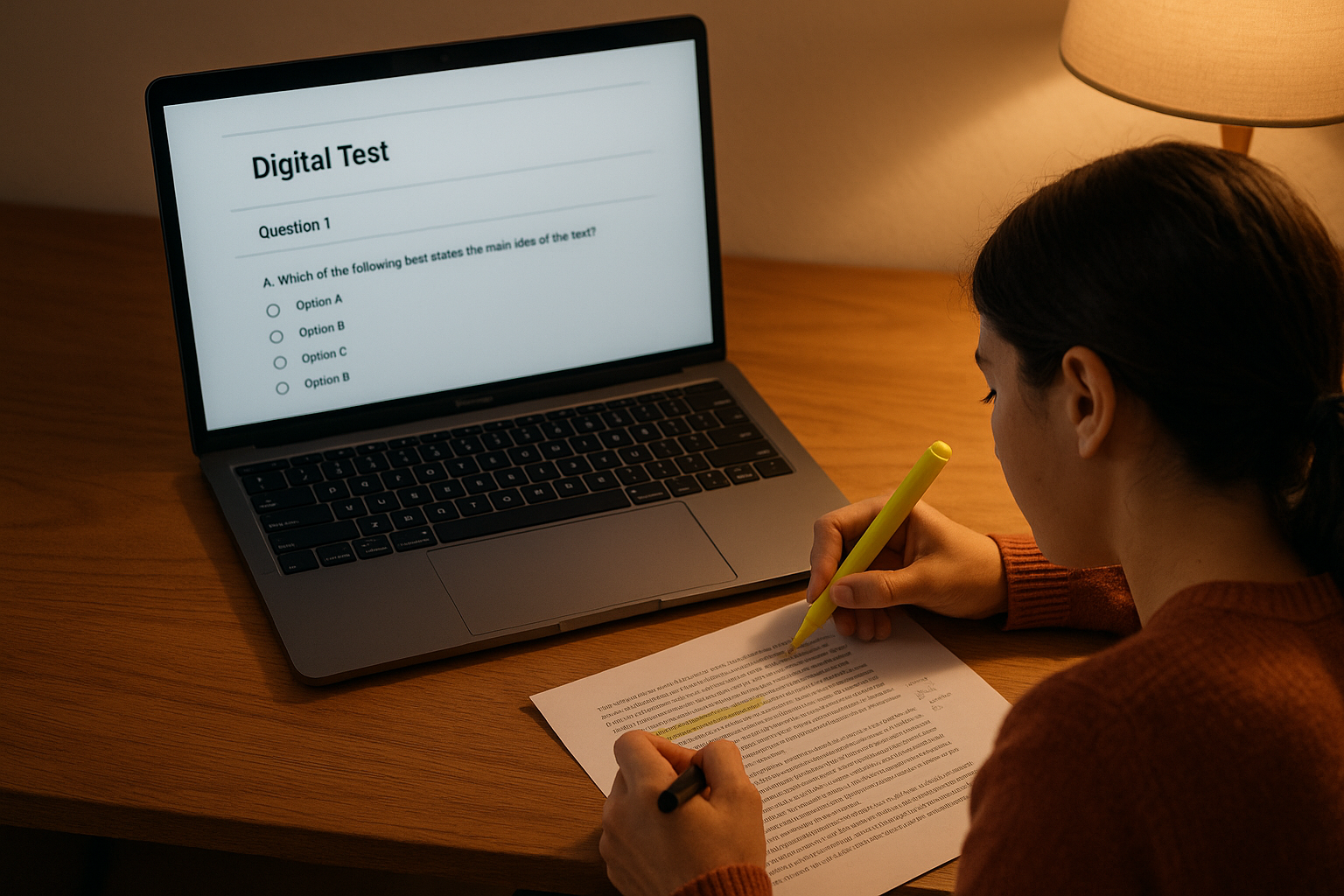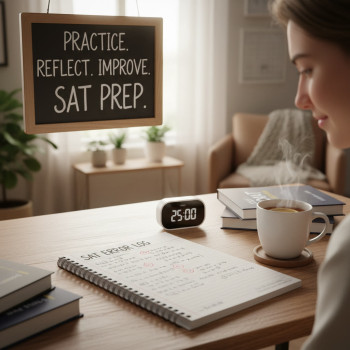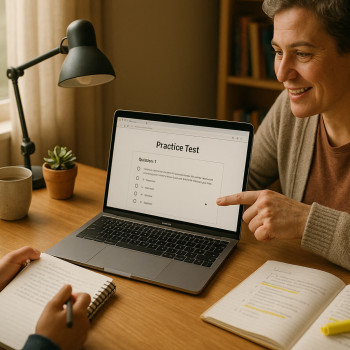Why Strong Readers Dominate the SAT
If you’ve ever watched a teammate breeze through a reading passage while you’re still hunting for the main idea, you’ve seen the truth in one of the quietest secrets of the SAT: reading well isn’t just about loving books — it’s a superpower for this test. The Digital SAT rewards students who can quickly understand structure, evaluate evidence, and interpret tone. In practice, that means strong readers often convert skill into points faster and with less anxiety.
A friendly (but important) distinction: reading fast isn’t the same as reading well
Speed matters on the SAT, but accuracy matters more. A calm, strategic reader who skims blindly will likely flinch at nuance and misread evidence. Conversely, a reader who understands how passages are built — the author’s purpose, the arc of an argument, the subtle switch in tone — can navigate questions with surgical precision. The goal is efficient comprehension: get to the point where passages reveal their structure to you without draining time or energy.
The structure of the Digital SAT’s Reading and Writing section — and why reading matters
Although the Digital SAT updated its delivery and some question formats, the fundamentals remain: the Reading and Writing portion tests comprehension, analysis, and evidence-based reasoning. Questions ask you to identify main ideas, interpret words in context, evaluate the function of sentences or paragraphs, and choose the best evidence for a claim. That’s a laundry list of classic reading skills — nothing mystical — which is why students who read widely and with purpose tend to score better.
What strong readers do differently
- They identify the thesis or main point quickly and use it as a compass.
- They track the author’s viewpoint, shifts in tone, and the structure of reasoning.
- They evaluate evidence by connecting specific lines to big-picture claims.
- They interpret words in context without overrelying on dictionary definitions.
- They eliminate answers based on logical mismatch rather than fuzzy memory.
Real examples: how reading skills turn into SAT points
Let’s fold reading skill into real test behavior. Imagine a 300–400 word passage about the decline of a local newspaper. The author opens with a statistic, moves to an anecdote about a longtime reporter, and ends with a projection about community consequences. A strong reader will:
- Note the sequence: statistic → anecdote → projection. That clues you into which paragraphs are evidence and which deliver conclusions.
- Tag the paragraph that contains a prediction; questions asking “which sentence best supports the author’s prediction” become easier.
- When a question asks about tone, the reader draws on the anecdote’s emotional weight vs. the statistic’s dispassionate fact to choose between subtly different answer choices.
These moves — sequence recognition, tagging evidence, weighing tone — are repeatable and teachable. That’s the good news: you don’t need to be a natural-born bookworm to learn them.
Example comparison: two students on the same passage
| Student A (Strong Reader) | Student B (Struggling Reader) |
|---|---|
| Skims first paragraph, identifies thesis, tags evidence lines as supporting/illustrating | Reads sequentially, remembers facts but not structure, confused by inference questions |
| Answers inference questions by referencing exact evidence; efficient elimination of wrong choices | Chooses an answer that “sounds right” but doesn’t match passage wording precisely |
| Finishes with time for review and catches one careless mistake | Runs out of time or rush-reviews, increasing error rate |
How reading skill maps to specific SAT question types
Instead of vague platitudes, let’s connect reading habits to concrete question types you’ll see on the Digital SAT:
- Main idea and primary purpose questions → Benefit directly from the ability to summarize a passage in a sentence or two.
- Evidence support questions → Depend on line-to-claim mapping and the habit of underlining or mentally tagging evidence.
- Inference questions → Require controlled extrapolation, not guesswork; good readers limit inferences to what’s supported.
- Vocabulary in context → Strong readers use context clues (syntax, tone, contrast) rather than memorized word lists.
- Function/structure questions → Reward readers who notice transitions, paragraph breaks, and rhetorical moves.
Why “close reading” is the SAT secret sauce
Close reading — the practice of reading to notice structure, argument moves, and tone — gives you an analytical lens. On the SAT, every question is an invitation to show you were paying attention. If you’ve practiced extracting the skeleton of passages, you can answer in ways that are defensible and fast.
Strategies to build the reading skills that directly increase SAT scores
If you want to convert reading ability into SAT points, take an approach that’s deliberate and measurable. Here’s a study-friendly pipeline:
1) Make structure your habit
For every practice passage, write a one-sentence summary and note the function of each paragraph. That’s three minutes well spent: it trains your brain to spot what the test is asking about and makes evidence questions obvious.
2) Practice evidence-matching
When a question asks for support, stop and underline the exact phrase in the passage that proves the answer. If you can’t find it, you don’t have the correct option. This prevents appealing-to-memory mistakes and helps when you need to justify your answer on tougher items.
3) Read with questions
Before you dive into a passage, glance at the questions — not to locate answers immediately, but to prime your reading. Knowing that an inference question waits will make you more alert to implied meanings, and knowing a vocabulary question is coming will focus you on context clues.
4) Build word knowledge via context, not cram lists
Life on the SAT is about being nimble with language. Instead of memorizing thousands of flashcards, practice deriving meaning from sentence context, antonyms/synonyms in nearby clauses, and sentence structure. That skill transfers to any unfamiliar word.
5) Time management drilled with purpose
Use timed practice to learn when to slow down. Not every passage deserves the same level of focus — science pieces often need more attention to detail, while narrative sections can be navigated with an eye for tone and character. Time your passes and track which types cost you the most time.
Study plan blueprint: 8 weeks to better SAT reading
The following weekly plan turns scattered practice into steady improvement. Adapt the pace to your starting point, but keep the principles intact: daily deliberate practice, weekly review, and regular full-length timed practice.
| Week | Focus | Routine |
|---|---|---|
| 1 | Diagnostics & baseline | Take a digital practice Reading&Writing section untimed; note weaknesses |
| 2 | Structure & main idea | Daily: 2 passages, one-sentence summaries, paragraph function notes |
| 3 | Evidence & support questions | Daily: evidence matching for every support question; track misses |
| 4 | Inference & tone | Daily: practice inference questions; read opinion pieces to sense tone |
| 5 | Vocab-in-context | Daily: 10 contextual vocab items; note morphology and sentence cues |
| 6 | Timed strategy | 3 timed passages per day; simulate test pace and practice efficient review |
| 7 | Mixed practice & weak-spot repair | Target weak question types and revisit tough passages |
| 8 | Full official practice & review | Take a full digital SAT; analyze every wrong answer and plan final tweaks |
How to practice reading outside official tests — make it real and fun
Better reading doesn’t have to be a slog. Mix genres and formats, and focus on active reading rather than passive consumption:
- Editorials and essays: practice spotting argument structure and evidence.
- Science summaries and popular research articles: train precision and detail-tracking.
- Short fiction and personal essays: sharpen tone and inference skills.
- Podcasts and radio essays (transcripts): learn how spoken structure maps to written arguments.
When you read, annotate. Circle thesis sentences, underline evidence, and write a margin note summarizing each paragraph in a word or two. These small actions translate directly into test-ready habits.
Common reading pitfalls and quick fixes
- Pitfall: Answering from memory. Fix: Always find the line that proves your choice.
- Pitfall: Overthinking tone or author intent. Fix: Anchor tone judgments to specific words or phrases; ask “What makes me say that?”
- Pitfall: Spending too much time on a difficult passage. Fix: Flag it, move on, return if time allows — preserving easy points is crucial.
- Pitfall: Vague vocabulary answers. Fix: Re-phrase answer choices in your own words and compare to the sentence context.
The role of tutoring and targeted guidance
One-on-one support accelerates progress because it personalizes the process. Tutors can identify your specific reading blind spots — whether you miss inference cues, lose track of structure, or misapply time — and tailor practice accordingly. Sparkl’s personalized tutoring, for example, offers tailored study plans, expert tutors, and AI-driven insights that highlight patterns in your mistakes. When used sparingly and strategically, tutoring isn’t a crutch; it’s a catalyst that turns practice into measurable improvement.
How personalized tutoring fits into your study plan
- Use tutoring early to diagnose patterns and build a custom strategy.
- Ask tutors for modeled think-alouds on passage types you find intimidating.
- Schedule periodic check-ins to adjust pacing and focus as your scores change.
- Leverage AI-driven insights (where available) to spot trends across dozens of practice tests.

Measuring progress: what improvement looks like
Progress shows up in two places: speed and accuracy. At first you’ll likely gain accuracy as you adopt evidence-focused habits. Later, speed improves because you know which parts of passages demand attention and which can be skimmed. A reliable indicator of growth is the ratio of correct evidence questions to total evidence questions — if that percentage climbs steadily, you’re learning to anchor answers in the passage rather than guess.
Quick self-check questions
- Can I summarize this passage in one sentence without flipping back and forth?
- When asked to cite evidence, can I point to the exact line that supports my answer?
- Do I recognize common transitions that signal contrast, cause, or conclusion?
- After practice, do I find I’m making fewer careless errors when I review my work?
Putting it all together: a student story
Think of Maya, a junior who loved English but panicked under test pressure. Her baseline digital practice showed she missed many evidence questions and ran out of time. With an 8-week plan, daily structure work, and weekly sessions with a Sparkl tutor who modeled close-reading and provided tailored practice sets, Maya learned to tag thesis sentences, mark evidence, and pace herself. She didn’t become a different reader overnight — she built test-specific habits. Her reading section jumped, and more importantly, she felt in control on test day.
Final thoughts: reading is a long-term advantage — and it’s teachable
Strong readers excel on the SAT because the test rewards depth of comprehension, careful use of evidence, and a disciplined approach to language. The promising part is that these are learnable, practised abilities. You don’t need to read every classic novel to succeed; you need deliberate, targeted practice that turns curiosity into strategy.
If you’re aiming for a meaningful score improvement, combine consistent practice with strategic help. Personalized tutoring — like Sparkl’s tailored study plans and one-on-one guidance — can speed progress by pinpointing your exact weak spots and keeping your practice efficient. Use practice tests to measure growth, focus on evidence-driven habits, and remember: every passage you analyze strengthens the toolkit you’ll use on test day.
A short checklist for your next week
- Take one untimed diagnostic Reading & Writing section to identify weaknesses.
- Practice six passages with structure summaries and evidence underlining.
- Do three timed passages to practice pacing; review every incorrect answer.
- Read one editorial or science article and write a one-sentence summary plus paragraph labels.
- Consider a targeted tutoring session if you have recurring mistake patterns.
Remember: reading well is more than test prep — it’s preparation for college and beyond
At the end of the day, the SAT is a snapshot: it rewards the same analytical reading skills you’ll use in college classrooms, internships, and real-world problem solving. Building reading strength gives you an advantage that pays dividends long after the score report arrives. So keep reading, keep practicing with purpose, and treat each passage as practice for the bigger conversations ahead.
Good luck — and remember: smart habits beat last-minute panic. One passage at a time, you’ll get there.

















No Comments
Leave a comment Cancel